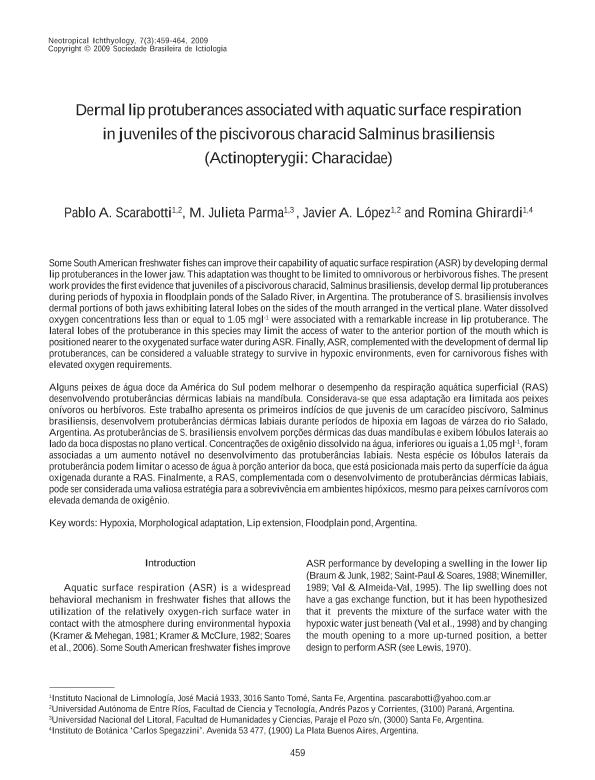Artículo
Dermal lip protuberances associated with aquatic surface respiration in juveniles of the piscivorous characid Salminus brasiliensis (Actinopterygii: Characidae)
Fecha de publicación:
12/2009
Editorial:
Sociedade Brasileira de Ictiología
Revista:
Neotropical Ichthyology
ISSN:
1679-6225
Idioma:
Inglés
Tipo de recurso:
Artículo publicado
Clasificación temática:
Resumen
Some South American freshwater fishes can improve their capability of aquatic surface respiration (ASR) by developing dermal lip protuberances in the lower jaw. This adaptation was thought to be limited to omnivorous or herbivorous fishes. The present work provides the first evidence that juveniles of a piscivorous characid, Salminus brasiliensis, develop dermal lip protuberances during periods of hypoxia in floodplain ponds of the Salado River, in Argentina. The protuberance of S. brasiliensis involves dermal portions of both jaws exhibiting lateral lobes on the sides of the mouth arranged in the vertical plane. Water dissolved oxygen concentrations less than or equal to 1.05 mgl-1 were associated with a remarkable increase in lip protuberance. The lateral lobes of the protuberance in this species may limit the access of water to the anterior portion of the mouth which is positioned nearer to the oxygenated surface water during ASR. Finally, ASR, complemented with the development of dermal lip protuberances, can be considered a valuable strategy to survive in hypoxic environments, even for carnivorous fishes with elevated oxygen requirements
Palabras clave:
Hypoxia
,
Morphological adaptation
,
Lip extension
,
Floodplain pond
,
Argentina
Archivos asociados
Licencia
Identificadores
Colecciones
Articulos(INALI)
Articulos de INST.NAC.DE LIMNOLOGIA (I)
Articulos de INST.NAC.DE LIMNOLOGIA (I)
Citación
Scarabotti, Pablo Augusto; Parma, Maria Julieta E.; Lopez, Javier Alejandro; Ghirardi, Romina; Dermal lip protuberances associated with aquatic surface respiration in juveniles of the piscivorous characid Salminus brasiliensis (Actinopterygii: Characidae); Sociedade Brasileira de Ictiología; Neotropical Ichthyology; 7; 3; 12-2009; 459-464
Compartir




